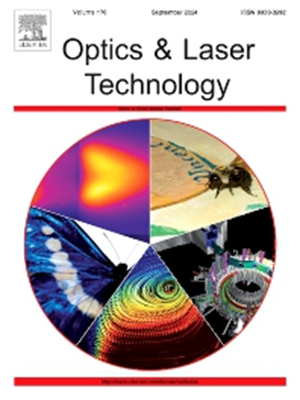Adaptive optics aided OAM modes generation in modulating retroreflector free-space optical systems
IF 4.6
2区 物理与天体物理
Q1 OPTICS
引用次数: 0
Abstract
Modulating retroreflector (MRR) free-space optical (FSO) communication systems have attracted attentions in asymmetric optical wireless communication applications. However, the double-pass atmospheric propagation and the planar modulator in the MRR FSO communication system led to relatively large turbulence-induced fading and relatively low modulation efficiency. This work combines an adaptive optics phase compensation method with an orbital angular momentum (OAM) generation method at the MRR terminal by using a spatial light modulator with optical retroreflectors to achieve the fading mitigation and the OAM transmission. The adaptive optics aided OAM generation approach is carried out in wave-optics simulation and the simulation results show that the approach provides a significant phase compensation effect and an improved OAM mode purity at the transceiver. It is evident that the proposed approach could considerably reduce the impact of atmospheric turbulence on OAM wavefront and promote the application of OAM modes in MRR FSO communication systems.
求助全文
约1分钟内获得全文
求助全文
来源期刊
CiteScore
8.50
自引率
10.00%
发文量
1060
审稿时长
3.4 months
期刊介绍:
Optics & Laser Technology aims to provide a vehicle for the publication of a broad range of high quality research and review papers in those fields of scientific and engineering research appertaining to the development and application of the technology of optics and lasers. Papers describing original work in these areas are submitted to rigorous refereeing prior to acceptance for publication.
The scope of Optics & Laser Technology encompasses, but is not restricted to, the following areas:
•development in all types of lasers
•developments in optoelectronic devices and photonics
•developments in new photonics and optical concepts
•developments in conventional optics, optical instruments and components
•techniques of optical metrology, including interferometry and optical fibre sensors
•LIDAR and other non-contact optical measurement techniques, including optical methods in heat and fluid flow
•applications of lasers to materials processing, optical NDT display (including holography) and optical communication
•research and development in the field of laser safety including studies of hazards resulting from the applications of lasers (laser safety, hazards of laser fume)
•developments in optical computing and optical information processing
•developments in new optical materials
•developments in new optical characterization methods and techniques
•developments in quantum optics
•developments in light assisted micro and nanofabrication methods and techniques
•developments in nanophotonics and biophotonics
•developments in imaging processing and systems

 求助内容:
求助内容: 应助结果提醒方式:
应助结果提醒方式:


